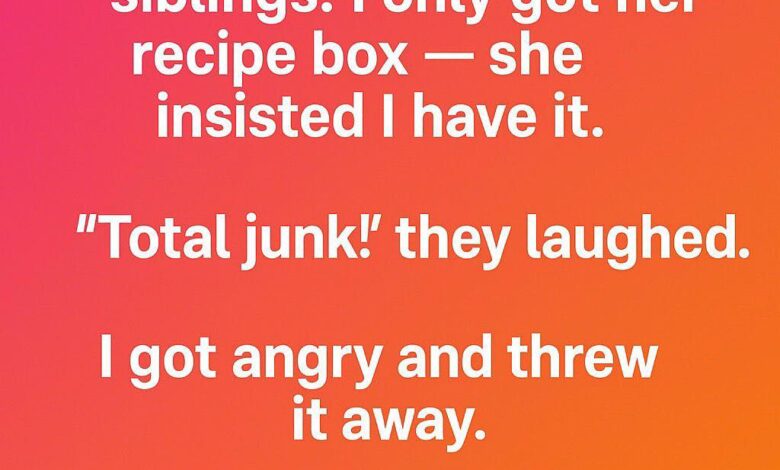
When my grandmother moved into a nursing home, everyone expected a dramatic dividing of her belongings. She had spent her entire life collecting things that looked valuable—china sets polished to a shine, jewelry in velvet boxes, antique lamps she guarded like they were national treasures. My siblings practically lined up, waiting to see what they’d inherit. They walked away with gold rings, crystal bowls, framed oil paintings. And me? She handed me a small wooden recipe box, worn at the corners and smelling faintly of cinnamon and age.
I won’t lie. My heart dropped. I tried to smile, but it felt forced, stiff, fake. My siblings barely tried to hide their smirks. “Guess you got the leftovers,” one of them joked. “Junk drawer stuff.” The words landed harder than I expected. For years, I believed my grandmother saw something special in each grandchild. Now I wasn’t sure. A recipe box? Really?
When I got home later that afternoon, frustration still burning in my chest, I left the box near the trash. I didn’t throw it away—just set it down, telling myself I’d look through it later. But honestly, I didn’t plan to. My mind was too clouded with embarrassment, jealousy, and the nagging thought that maybe my grandmother didn’t think I deserved anything better.
As I stepped outside to get the mail, my neighbor, Mrs. Allen, noticed the box sitting by the trash bin. She tilted her head and walked over with that soft concern older women seem to master. “Are you getting rid of this?” she asked.
“I don’t know,” I muttered. “It’s just some old recipes.”
She looked at me the way a teacher looks at a student who clearly hasn’t done the reading. “Sweetheart,” she said, “do you know what this is?”
Before I could answer, she picked up the box and carried it inside like it was something fragile. I followed her, mostly out of curiosity and a little guilt. She set the box gently on my kitchen table and opened it. The hinges creaked, and inside lay rows of handwritten recipe cards. But they weren’t just recipes. She reached in and pulled out an envelope, then a stack of photos. There were notes scribbled in the margins, dates, memories, little bits of family history tucked between ingredients and instructions.
“This isn’t a recipe box,” she said quietly. “This is a life story.”
I sat down, suddenly ashamed at how quickly I dismissed it. She placed a card in my hand—my grandmother’s handwriting looping across the front. A recipe for apple pie. But under it, in smaller letters: “Baked this for Johnny’s first birthday. He cried when the crust broke.” Johnny was my father. The handwriting looked almost brittle, like it carried the weight of decades.
Another card: chocolate chip cookies. A note beneath the ingredients read, “Let the dough rest. Don’t rush. Good things come slow.” Next to it, a photo of my grandmother at a kitchen counter, flour on her cheek, laughing at something outside the frame.
Mrs. Allen kept digging, and each item hit me harder than the last. There were newspaper clippings, folded letters, tiny keepsakes wrapped in tissue. A small ribbon with a safety pin still attached. A pressed flower between two index cards. And every single thing had a story, written in my grandmother’s careful, deliberate script.
“This,” Mrs. Allen said, tapping the lid of the box, “is love. This is legacy. She didn’t leave you junk. She left you her heart.”
Her words knocked the wind out of me. Suddenly I understood. My siblings got things that looked valuable. Pretty items to display on shelves, pieces to brag about later. But I was the one who sat with my grandmother on slow afternoons, listening to her talk about her childhood. I was the one she called when her knees hurt too much to stand at the stove. I was the one who learned how she folded dough, how she measured spices by instinct, how she told stories while food simmered on the stove.
She didn’t give me less. She gave me the part of her she thought I would understand.